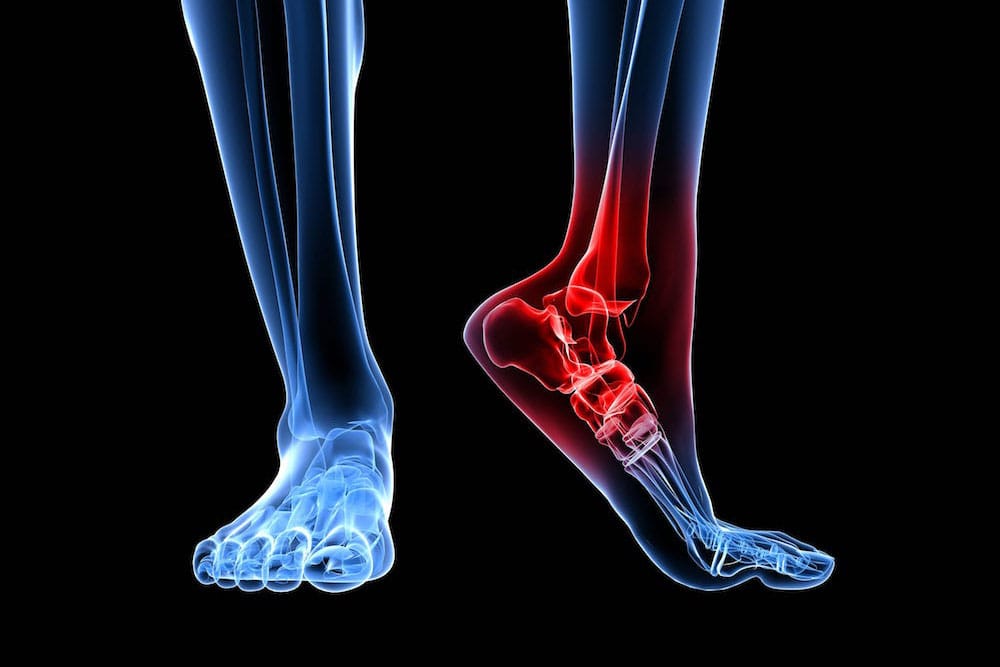Foot and Ankle Trauma

What is foot and ankle trauma?
Foot and ankle trauma describes any number of injuries sustained by the foot and the ankle, including but not limited to sprains, tendon ruptures, fractures, and dislocations. Foot and ankle trauma can also include fractures that have not healed well, or in the proper position. We care for a wide range of foot and ankle trauma and the most common conditions we see include:
- Foot contusions (bruises)
- Soft tissue injuries
- Toe fractures
- Complex crush injuries to the foot
- Severe foot fractures
Contusions (Bruises)
Contusions are bruises that crush the underlying muscle fibers and connective tissue without breaking the skin. They can be caused by a direct blow or repeated blows to the foot and/or ankle, or by falling or jamming them against a hard surface.
You can see a contusion because the skin will be discolored by the blood pooling around the internal injury.
Most contusions respond well to rest, ice and elevation. However, if they do not respond and the discomfort and discoloration continue, a podiatrist should be seen to avoid long lasting damage to the soft tissue in the area of the contusion.
Soft-tissue injuries
Soft tissue injuries fall into two categories; acute injuries and overuse injuries. Acute injuries are caused by sudden trauma like a fall or blow to the body. These include sprains, like ankle sprains (you can read more about them here)jump link to our ankle sprain page) strains, and contusions. Overuse injuries (you can read more about them here)jump link to sports medicine page Overuse injuries subhead)are caused by activities that require repetitive motions by the same part of the body, without time to heal in between.
Soft tissue injuries cause pain and swelling and can restrict motion of the foot or ankle. This type of trauma can be treated with a range of successful methods, from ice and rest to surgery. Your podiatrist will diagnose the specific soft-tissue injury you have sustained, and then determine the most effective treatment.
Toe and Metatarsal Fractures
Toe and metatarsal (the bones in the foot) fractures are painful and can occur in several different ways.
- Stress fractures; These tiny cracks occur along the surface of the bones in your toes. They can be caused by tripping, falling or suddenly increasing the intensity of workouts, running or walking.
- Bone breaks without shifting the alignment of the bone. These types of breaks commonly occur when you drop something heavy on your foot.
- Breaks on the side of the little toe. Dancers can suffer this type of break from falling on, or twisting their foot.
- The tendon in the foot is torn away from the bone and pulls a small piece of bone away.
- A Jones fracture occurs near the base of the bone and disrupts its blood supply.
Each of these fractures can be treated by a skilled podiatrist to make sure that it heals properly and retains proper function of the foot.
Complex crush injuries to the foot
Crush injuries to the foot are very serious and require emergency care. These injuries can involve broken bones and can prevent blood flow to the foot. They can involve large wounds and blood loss. Crush injuries must receive a detailed assessment and expert care to stem bleeding and repair broken bones. Surgery may be required. If the vascular system (veins and arteries) in the foot can be stabilized, bones can be repaired with screws, wires and plates. Recovery occurs under a physician’s care and can include rehabilitation, physical therapy, ice, rest and elevation of the crushed foot.
Severe foot fractures
A severe foot fracture is a break in the bone caused by a sudden blow to the foot. When the bone breaks it can either stay in place or move out of position, which is called “displaced”. Is you suffer a severe foot fracture, you may hear the bone break, experience severe pain at the point of the break, notice a crooked or abnormal appearance in the toe or foot, and/or see bruising and swelling. If you experience any of these symptoms it is important to see a podiatrist right away. The old adage of “If you can walk on it, it’s not broken” is not true.
You can read more about fractures here. (jump link to sports medicine page)
